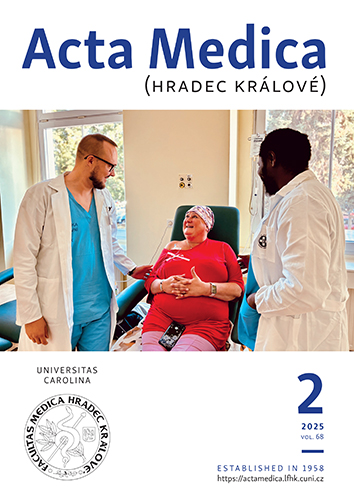ACTA MEDICA, Vol 65 No 1 (2022), 18–24
Contactless Measurement of Integrity of Silicone Coating on Self-Expandable Esophageal Nitinol Stents
Martin Kopeček, Jiří Záhora, Aleš Bezrouk
DOI: https://doi.org/10.14712/18059694.2022.11
zveřejněno: 29. 06. 2022
Abstract
Objectives: A stent is a mesh tube inserted into a natural passage in the body to prevent disease induction. Self-expandable esophageal nitinol stents such as SX-ELLA Stent Esophageal HV (HV Stent Plus) can be indicated for palliation of malignant esophageal strictures, for the treatment of benign esophageal strictures that are refractory to standard therapy and for the treatment of esophago-respiratory fistulas. A silicone-stent coating is used for tumor in-growth prevention and esophago-respiratory fistula occlusion. The thickness of the stent and the overall integrity of the silicone coating of all wires indicate the overall mechanical properties of the esophageal stent and the resistance to external adverse events such as corrosion and mechanical and chemical resistance. Methods: The polymer multicomponent epoxy resin – a mixture of Epon and Durcupan – was used as a method for robust sample stabilization. A cutting system using a thin water beam with a powder (Blue Line) was chosen as the best variant to obtain 6 samples for both-sided measurement (10 measuring sides). The optical microscopic reflective light method was used to examine wire crossing points in the sections. Fifty values were measured on either sample side for the internal, external and mesh thickness of the silicone stent layer. The wire crossing points were selected so that the silicone layer structure could be clearly seen, and the wires approached each other most closely. Only approximately 4 to 8 crossing points in each section could be measured when applying this approach. The resolution of the microscope and calibration (based on the camera used) was 0.677 μm/pixel. Results: Additional data could be obtained on 8 planes. Two boundary samples were destroyed by the cutting process. Whole coating of the stent was around all mesh wires, especially in areas with higher mechanical stress (wire crossing). The minimum detectable and admissible value determined for all 3 measuring areas (internal, external, mesh) on the wire crossings was 6.77 μm, i.e., 10 pixels, based on the microscope resolution and manufacturer’s methodology. The results were characterized by p < 0.001 for all 3 parameters. We tested opposite samples in each section to verify the section quality and data consistency. For the 4 areas, the data were significantly different, but the thickness differences were only on the order of units percent, so the measurements were not appreciably affected. We assume that the material cutting loss, making up 1–2 mm, contributed to the differences in the sections. Conclusion: We examined the overall integrity of the silicone coating of the esophageal stent. The method of HV stent anchoring in a polymeric bath followed by cutting with a waterjet and sample measurement under an optical microscope proved to be very simple and reliable. Sufficient thicknesses of the silicone layer on the wire cross sections were verified. The coated silicone layer thickness appeared to be significantly different along the stent from the proximal part to the distant part, presumably due to the manufacturing technology.
klíčová slova: nitinol; stent; self-expandable; memory materials; CNC technology; epoxy resin; contactless; optical method; silicone coating

Contactless Measurement of Integrity of Silicone Coating on Self-Expandable Esophageal Nitinol Stents is licensed under a Creative Commons Attribution 4.0 International License.
210 x 297 mm
vychází: 4 x ročně
cena tištěného čísla: 150 Kč
ISSN: 1211-4286
E-ISSN: 1805-9694
